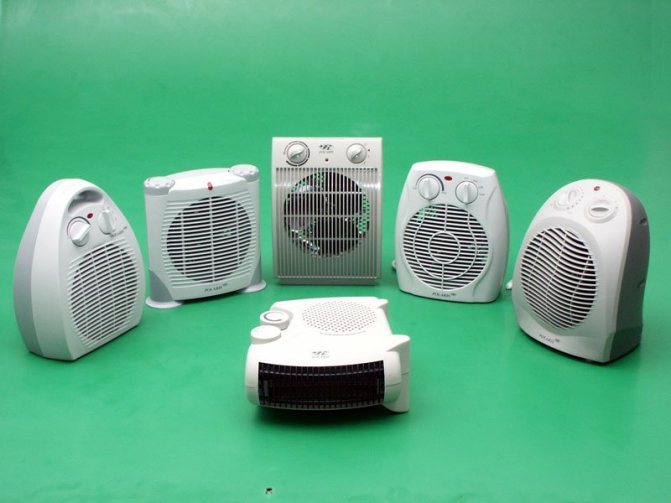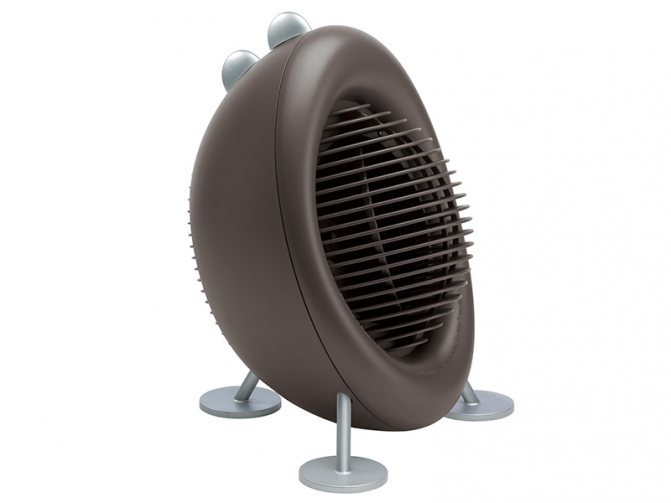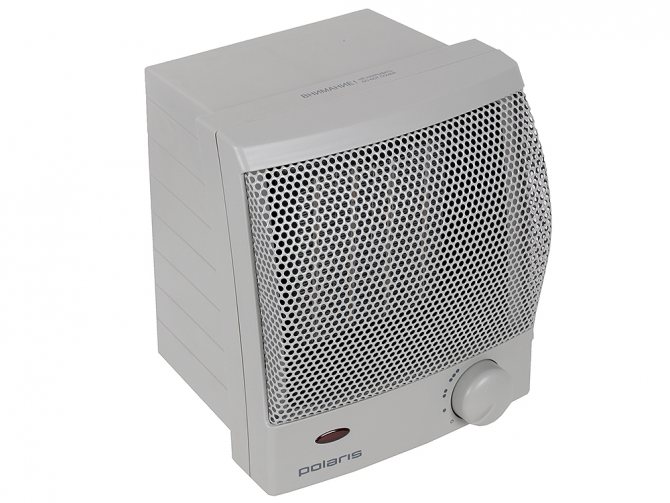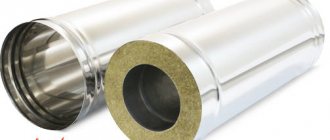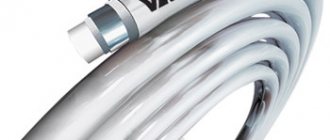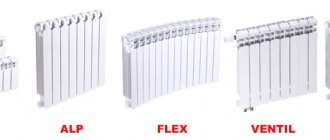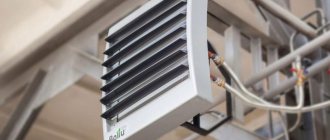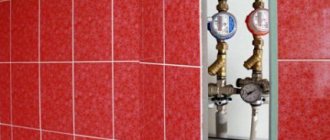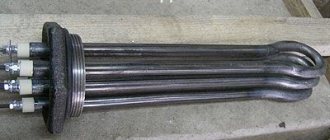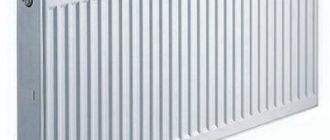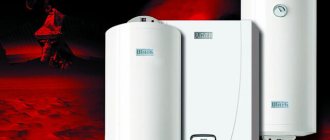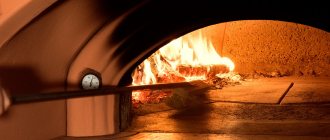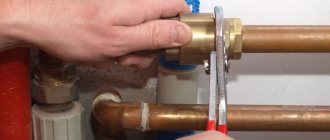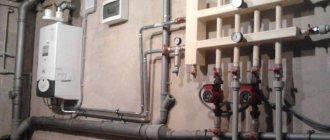How does a fan heater work
Any fan heater consists of three main parts: a housing, a heating element and a fan.
The principle of operation is extremely simple. The fan captures cold air and directs it to the heating element, where it warms up. With the help of the same fan, the air is blown back into the space already warm.
Because of this mechanism, the devices were nicknamed "wind turbines" or "fan heaters".
All of the above elements can have a different structure, the reliability and functionality of the equipment depend on it. So we will talk about each detail in detail.
The main disadvantage of all heating devices is the noise produced, which is explained by the rotation of the blades. In terms of loudness, they are classified as follows (from quietest to noisiest):
- infrared;
- oil and convector;
- fan heaters and heat guns.
So get ready for the monotonous hum. Moreover, the more powerful the unit, the louder it works.
But this minus does not detract from the main advantage - the rapid heating of the room. This happens precisely because of the presence of a fan. It enhances the circulation of air masses, and a comfortable microclimate is achieved in a short time.
Advantages and disadvantages
Fan heaters work constantly according to a given program. The heat is evenly distributed in the room thanks to the forced air. Tabletop appliances are transferred to the desired location and heat a specific area. Wall-mounted units create targeted air curtains where cold air is most exposed.
The disadvantages are that fans (except for ceramic appliances) dry the air, so manual humidification or installation of an appropriate system is required. Non-electrical devices such as heat guns or diesel ovens pose a risk of poisoning from fuel vapors.
Device classification
One of the options is the division according to the scope:
- industrial - high-performance installations designed for round-the-clock operation and with improved characteristics;
- household - inexpensive and compact copies used in houses and apartments.
The main feature by which all devices are classified is the installation method. The equipment is divided into two groups: stationary and mobile.
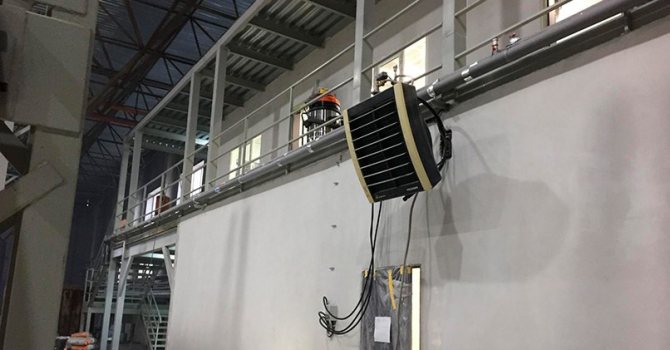
Stationary
This technique requires solid fasteners. It cannot be relocated at a time and often requires site preparation.
But this category of electric heaters, as a rule, is distinguished by increased power and expanded functionality. Therefore, the object can be used even as the only heating device.
Such a system is also safer, since there is no possibility of overturning or getting inside a random object.
As a rule, these samples are equipped with a remote control via a remote control. Otherwise, you will have to climb onto a chair or ladder and manually adjust the settings.
There are two options for fixed mounting.
- Wall
In appearance, they resemble air conditioning. Some models are equipped with swivel curtains, and then it is possible to direct the stream to where you need it. But most do not flow to the side, but strictly downward.
They are often installed to create a thermal curtain over doors. They heat and do not allow the cold from the street to get inside. This is especially true in organizations with high traffic: shops, hospitals, schools, etc.
- Ceiling
As the name implies, such specimens are attached to the ceiling, which means that efforts will be required during installation.But heaters direct warm masses in all directions and warm even a huge room.
Mobile
Due to their small size and weight, they are easy to move. Also, the device allows you to set the direction of the flow of heat and quickly warm up, for example, a bed. It is the best choice for an apartment in case of heating for a short period.
Among all the variety, there are two groups of devices.
- Floor standing - have a variety of designs: cubic, in the form of a column, a horizontal cylinder.
- Desktop - differ in the smallest size and weight. There are horizontal and vertical versions.
There are also combined products that are allowed to be placed in different positions. Heat guns are one of the varieties of mobile units.
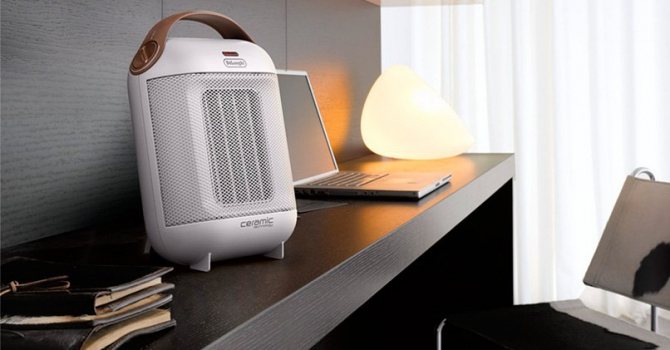

Material required to create a fan heater
To create a DIY fan heater with a water source of heat, you will need:
- A sheet of galvanized metal, or better stainless steel, about 1 mm thick. The body will be made of it, so the thickness of the material ensures the strength of the body.
- Copper tube for heat exchanger. The easiest way is if it is half an inch in diameter. You can also use a thin-walled metal pipe, but copper has a much better heat transfer. An ideal heat exchanger is a radiator from any small car. It can be purchased at auto dismantlers, at scrap metal collection points.
- Two end valves with couplings for connecting the heat exchanger to the central heating system. Some experts recommend flanged connections between the device and the heating system. It is believed that such a fastening is much more reliable than couplings.
- A fan, preferably a duct fan, but you can use any suitable model. The main thing is that it should create sufficient power and be powered from a 220 V household electrical network.
- Four springs for fastening the fan. The springs should not be too stiff. They are vibration dampers for the fan. Thanks to the spring mount, your water heater will run almost silently.
It would be very nice to buy a Mayevsky crane to bleed off air congestion, which is so "rich" in the central heating system.
Tool required to create a heater
- A jigsaw with a metal saw or a grinder with a cutting disc. Ideal for both.
- A drill, a set of drills for metal, pliers, a figured (Phillips) screwdriver, a set of hardware (nuts, bolts, washers, etc.).
- A die to thread the copper pipe. If the choice fell on a flange connection, then in this case you need a powerful soldering iron, flux for soldering copper and the metal flanges themselves, with a hole equal to the cross-section of the copper tube.
- Ruler, pencil, metal scissors.
Build process
Creating a water fan heater with your own hands, conditionally, needs to be divided into four stages: creating a case, depending on the span of the fan blades, creating a heat exchanger, the dimensions of which will depend on the size of the case, installation in a chosen place and connection to the heating system.
- We do the markup. Using a jigsaw, grinder or metal scissors, cuts a strip of metal to make an impromptu frame. The width of the stripe will be the same as the width of your device's body. The length of the strip will be equal to the length of the four sides of the device.
- Marks bend lines on the strip. The metal bending process is quite laborious, it requires skills.
- We connect the opposite ends of the strip with bolts or rivets. To do this, on the opposite ends of the strip, you need to make a flanging, about 1-2 cm.
- From the remnants of the material, they make a front panel, in which many large holes should be made for the exit of hot air.
- We attach it rigidly to the front side of the frame.
Stage 2
- We fill a copper tube with clean and dry sand, plug one end and bend the heat exchanger. Sand is needed so that there are no creases in the folds. After that, we release the sand from the heat exchanger and thoroughly blow it through.
- We drill two holes in the side of the case to bring out the ends of the heat exchanger.
- We cut threads at the ends of the heat exchanger to connect to the couplings.
- We solder the Mayevsky crane to the upper point of the heat exchanger.
Stage 3
- We assemble the device. First, a heat exchanger is mounted in the finished housing. On both sides, its ends are attached to the body with nuts. The remaining thread will be for screwing on the couplings.
- After that, a fan is installed behind the heat exchanger. To do this, small holes should be drilled in the corners of the case to fasten the springs. The other side of each spring should be put on the fan so that it is in the center of the device, like on guy wires.
Stage 4
- We mount the device on the wall so that there is a gap of at least 10 cm between the wall and the heater.
- We connect taps to the central heating pipes.
- Then, through the couplings, we connect to our fan.
Our water heater is ready. It is recommended to bleed the air before starting using the Mayevsky crane.
Power
The main question to be solved is: what kind of wind turbine is needed. After all, a device with a lower performance will not be able to effectively heat the home. And if you buy a device with high performance, then electricity consumption will increase.
Old aluminum wiring often fails and is flammable. Most of the sockets are designed for a maximum current of 16A: this corresponds to an equipment power of 3.5 kW.
The calculation is considered classic when 10 sq. m of the room requires 1 kW. It is also desirable to add a margin of 10-15%.
Apparatus for a small room or an addition to the heating system, 1-1.5 kW will be quite enough.
To calculate the power for heating only with an electric fan, you need to take into account many parameters - the number of windows, orientation to the cardinal points, the quality of double-glazed windows, climate, etc. It is better to entrust the calculation to a specialist, but you can do it yourself using a special calculator (available on the Internet).
Simplified formula looks like this:
W = S x W beats / 10, where
W is the required power;
S - heated area;
W beats - specific power required for heating 10 sq. m in your climatic zone.
| Climatic zone of Russia | W beats, kW |
| Southern regions | 0,7-0,9 |
| Middle lane | 1-1,2 |
| Northern regions | 1,5-2 |
A heating element
The central link of the whole mechanism is the heating element. It is he who largely determines the capabilities of a particular model. Even before buying, you will have to figure out which one is better - a spiral or ceramic heater to buy. Or maybe a water heat exchanger is right for you? Therefore, I urge you not to ignore such an important characteristic. There are three main types of parts.
Spiral
It is a thin nichrome wire wound in a spiral on a heat-resistant base. The heating temperature sometimes reaches 1000 degrees.
Such products are cheap and are quite suitable for a summer residence. That's all, this is where the advantages ended, then there are solid shortcomings.
- There is always a fire hazard due to the high temperature. This is possible if a piece of paper gets inside or a large lump of dust flies in.
- An electric current with a voltage of 220 V flows along the curl, which is life-threatening. You can touch the dangerous part through the bars with a thin child's finger or an oblong object.
- Dust and even small insects get inside. They give off unpleasant odors when burned.
- The service life is short.
Such an object should not work around the clock. You should give him a break.You can't leave him unattended yet. Although, having learned about the potential dangers, I think no one would think to be absent for a long time.
Heating element
This is the same spiral, but it is enclosed in a shell. Inside there is a free-flowing substance - quartz sand or manganese oxide. The heating of the flask is half that of the open part: about 500 degrees. In some cases, to improve heat transfer, special plates are installed on the heating element.
This option is characterized by much more pleasant characteristics:
- the problem of fire hazard is being solved;
- the energized link is insulated;
- less smell of burnt dust.
To be fair, I will say that such equipment is produced mainly with solid performance indicators. Therefore, there are few household appliances, an impressive part of goods with heating elements is industrial equipment.
Ceramic heater
The ceramic element is the best choice for the home. It is made in the form of ceramic plates and the heat exchange grill is made of corrugated aluminum. The design features and materials used give their benefits:
- the device does not heat up above 150 degrees, which means that it is not capable of causing a fire;
- consumes the least amount of electricity;
- lasts longer.
But I think you already guessed that this is an expensive group of devices. Although, due to energy savings, they pay for themselves pretty soon.
Water heat exchanger
Such objects are integrated into the heating system. They help to evenly heat even production halls and offices in a short time. They will not be able to operate during the off-season or when emergency heat supply outages occur.
The power of such heaters is directly related to the water temperature. If it is 80 or 90 degrees, then the maximum effect is achieved.
Fan
The design of this module determines the service life, the level of noise generated and the need for cleaning.
- Axial
It looks like a propeller in our usual sense. It has 3-8 blades, which are made of plastic or metal. This is a simple and budgetary mechanism, so it is most often found in household options. Another advantage: the part does not require maintenance and it is enough to occasionally lubricate it with machine oil.
And everything would be fine, but such products are buzzing strongly. Therefore, turning them on at night is not very comfortable.
- Radial
This element is typical for flat horizontal heaters. It looks like a wheel, around the circumference of which there are frequent parallel blades. The air is pumped by centrifugal acceleration.
The blown flow is smoother than that of the axial ones. If the wheel is well balanced and the blades are oiled, then little noise is generated.
- Tangential
It has a cylindrical shape and 20-30 parallel wings. It is the most productive and quietest, but due to design features it is not used in all devices. Among floor models, this type is not found in columns. But in wall and ceiling copies, an accessory of this type is not uncommon. The only upset is the need for regular cleaning.
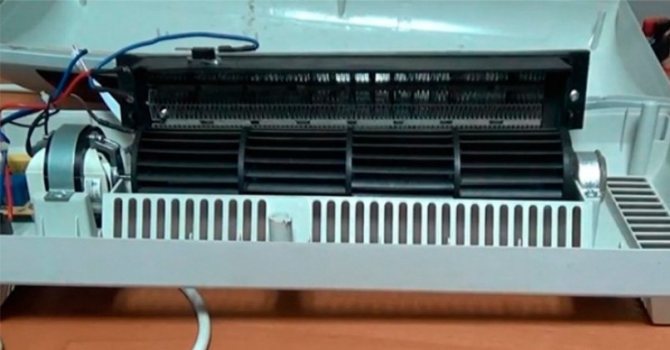

Body material
The body is made of plastic or metal. The first products are found much more often than the second.
Plastic devices are cheaper and much lighter than metal ones, but you need to pay attention to their quality. Cheap ones when exposed to high temperatures can melt and release harmful substances.
The metal sheath is most often found in expensive industrial facilities where the heating is significant. Plastic will simply not be able to withstand such treatment.
It is good if the body, regardless of the material, is splash-proof. Then the fan heater is allowed to be safely installed in the kitchen or bathroom.
Which manufacturer of fan heaters is better to give preference to?
It should be noted right away that the vast majority of fan heaters are assembled in the vastness of the People's Republic of China. However, leading brands are stricter and more careful in monitoring the quality of the materials used in the manufacture of their brand products and the quality of the assembly itself. With all the variety of brands, there are not so many worthy manufacturers. The designer models of the Swiss company Stadler Form not only provide comfortable and safe heating of premises, but also delight the eye with their stylish performance. The famous AEG brand is presented in the rating of one of the best universal wall-mounted fan heaters. Decent quality with good functionality and an affordable price are demonstrated by Timberk, Ballu, Rolsen and Vitek, already well-known on the heater market. Their advantage is a wide range of fan heaters for various conditions and for any wallet. What should be avoided are cheap products from little-known brands. Often, such products are simply not safe. Low-quality materials from which they are made can be toxic and flammable.
Control and functions
The simplest models are equipped with mechanical switches. To adjust, you only need to turn the knob. This is very convenient for those who are not friendly with modern technologies. For example, for the elderly.
More advanced designs are equipped with buttons or sensors with a display. Here, as a rule, the remote control is supplied.
Let's name the most popular options:
- power regulator - there is even the cheapest copies and is needed to adjust the intensity of the blowing;
- thermostat - a device with automatic temperature maintenance at a user-selected level;
- timer - allows you to program the on and off times;
- rollover sensor - useful for ensuring the safety of floor and table products;
- overheating protection - turns off the equipment if the temperature of internal components has reached a critical level;
- frost protection - automatic heating of the device up to +5 degrees Celsius prevents the unit from failing due to frost.
A dear helper is able to take on the “duties” of another technique:
- fan - a wind blower drives air masses without heating them;
- humidifier - corrects dry air caused by heating;
- air purifier and ionizer - the space is filled with useful negative ions and is cleaned thanks to the filter system.
The best fan heaters with a tubular heater
Hintek T-12380


A worthy representative of the Hintek line. Like other fan heaters of this brand, it is used for drying and heating industrial workshops, warehouses and retail premises. Compared to a convection radiator, this device heats up the air in the room much faster. It is also effective to use this device for drying rooms after construction, plastering or painting work.
Design features:
- power regulation stepwise;
- the ability to adjust the air temperature within 0-40 degrees;
- a stainless steel heating element does not contribute to the combustion of oxygen;
- reliable protection against overheating;
- high-strength steel body with anti-corrosion coating;
- silent electric motor.
Reviews about this device are only positive. Negative points were not identified.
Soler & Palau CB-2005 Inox


Stationary fan for wall mounting from a Spanish company. The manufacturer initially positions the device as a device for drying towels. In addition, the device is perfect for creating an optimal microclimate in the bathroom, that is, as a heater. IP24 protection class makes the device moisture resistant.
Advantages:
- minimum noise during operation;
- plastic housing;
- overheating protection (automated thermostat, built-in indicator);
- electrical safety class - II;
- the presence of an economical mode (maintaining the air temperature at a minimum level);
- 2 power modes: 1.0 and 1.8 kW;
- built-in air filter;
- manufacturer's warranty - 1 year.
There were no negative reviews.
Teplomash KEV-4S41E
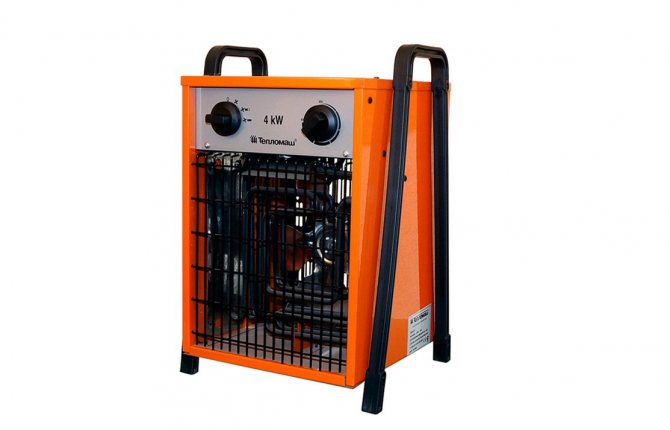

A compact and powerful device that has proven itself in both industrial and residential environments. The device has a convenient shape and relatively low power consumption. The heat fan is housed in a high-strength metal casing.
It is protected from insects and dirt with a special mesh. When using a heat gun, you can reach temperatures up to +40 degrees. Maintaining the set temperature is carried out using a thermostat. There are 2 power modes: 2.66 and 4.0 kW.
Benefits:
- heating of air in the room is fast and uniform;
- the possibility of using in a hot period for ventilation;
- the presence of an air ionizer;
- maintaining a given regime;
- relatively low energy consumption.
There are no downsides.
TOP-5 fan heaters
Determining the choice among all the variety is not easy. I hope this list of popular models will help you.
Ballu BFH / S-04 is the simplest unit for 750 rubles. A spiral is used here as a heater, and the fan has an axial structure. The increased power - 2000 W - allows it to be used in rooms up to 25 sq. m. There is one more mode - 1000 watts. Equipped with a thermostat to control overheating.
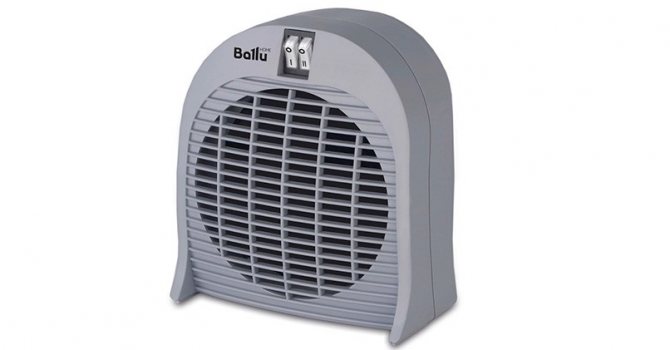

Pros:
- inexpensive;
- compact;
- coverage of a large area;
- warranty - 2 years.
Minuses:
- only two modes;
- short cord.
Electrolux EFH / C-5115 - desktop copy for 2,200 rubles. It is characterized by a power of 1500 watts. The special configuration ensures fast heat distribution. Appliances are equipped with modern ceramic elements. The choice between three possible settings is made by two rotary switches. This is a unit with a thermostat and an overheating sensor that turns off the device if necessary.
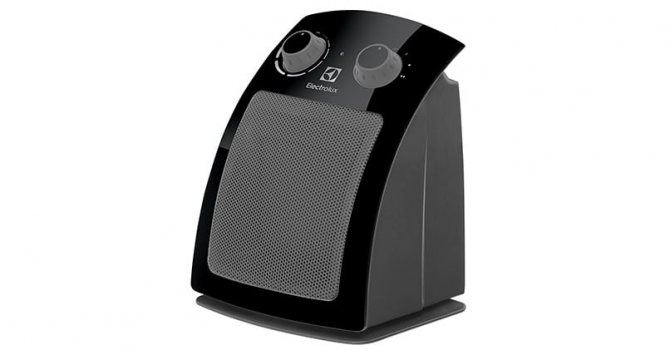

Pros:
- copes with space up to 20 sq. m;
- modern design;
- environmentally friendly and high quality materials;
- the case does not heat up.
Minuses:
- quite noisy;
- wire only 1 m long;
- low sensitivity thermostat.
Tefal Intense Comfort Hot SE9420F0 is a floor-standing column-shaped device for 11,000 rubles. The power of the ceramic heater is 2,400 W. Has a wide blowing angle - 90 degrees. Three modes are built in, including ventilation without heating, shutdown is provided for overturning and overheating. There is a thermostat, timer and delayed start, which allows you to program the operation up to 24 hours. I would especially like to note the ECO function, due to which electricity consumption is reduced by 50%
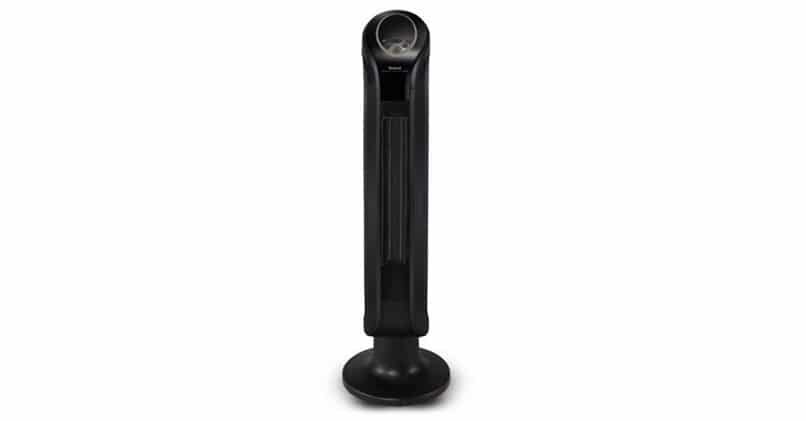

Pros:
- quiet;
- economical;
- long cord;
- there is a remote control.
Minuses:
- sound accompaniment of pressing buttons interferes at night;
- fingerprints are visible on the side panels.
Stiebel Eltron CK 20 Trend LCD is an elegant wall sample worth 14,500 rubles. The rectangular shape and white plastic with gray accents create a laconic design that will fit into any interior. Power - 2,000 watts. A wide range is available from +5 to +30 degrees. It has overheat shutdown functions, a weekly timer, and anti-freeze functions. Adjustment is carried out using sensors and a display.
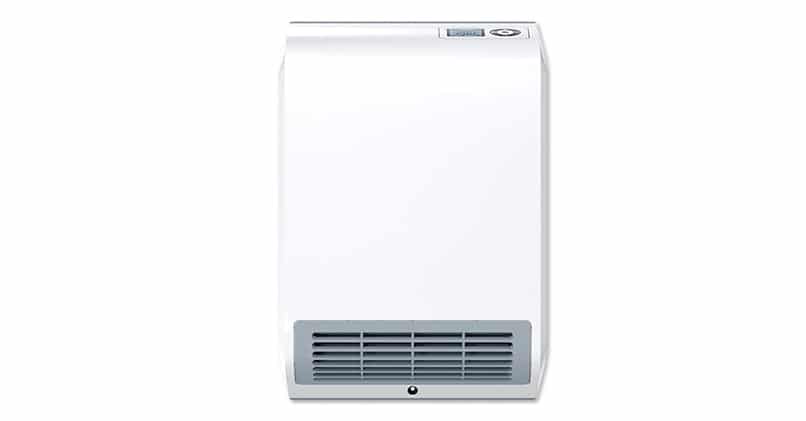

Pros:
- compact and lightweight;
- low noise level;
- there is a compartment for the cord.
Minuses:
- periodic cleaning of the air filter is required;
- no remote control.
Teplomash KEV-25T3W2 - industrial water heater for 18,500 rubles. Its power at a coolant temperature of 80 degrees is 8.3 kW, and at 90 degrees - 11.9 kW. He pushes warm air at a distance of 8 m from him.The included swivel bracket makes it possible to install the device on a wall or ceiling.
The set includes two control panels: a wired one (you will have to fix it next to the device) and a remote one. The casing is made of powder coated galvanized steel.
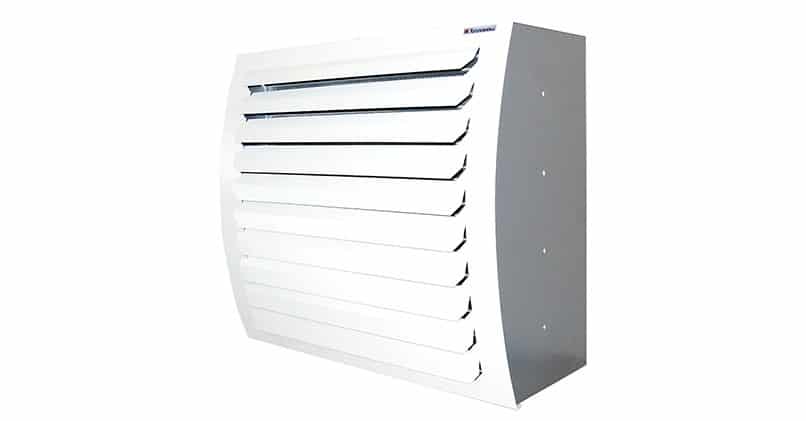

Pros:
- all the necessary fasteners included;
- energy efficiency;
- protection class against dirt and moisture IP44;
- adjustable lamellas.
Minuses:
- loud;
- complexity of installation.
Additional functions of fan heaters
To date, manufacturers of fan heaters have provided the consumer with a huge selection of various additional functions. In addition to, directly, heating, an electrical appliance may include the following functions:
- Ventilation without heating
- Automatic temperature maintenance
- Antibacterial air filtration
- Ionization
- Air humidification
- Sleep timer
- Digital display with selectable backlight color
- Current and set temperature indicator
- Remote control capability
- Overheating shutdown
- Roll-over shutdown
- Self-diagnosis of faults
- Tilt angle adjustment
- Swivel base
- Thermostat
- Splash proof
- Frost protection
Of course, the cost of the device will directly depend on the presence or absence of certain features. In order not to overpay, it is worthwhile to disassemble each of them in detail and make sure of its necessity.
The function of ventilation without heating will allow you to use the fan heater not only in cold weather, but also create an optimal temperature in the room in summer. It will be very convenient and worth paying attention to, both when purchasing a mobile device and a stationary one.
Automatic temperature maintenance will be a useful function if the device is used in an apartment for a long time. Undoubtedly, such a function will save energy, which is also very nice.
Antibacterial air filtration is present in more expensive fan heaters. However, you should not save if a child spends a lot of time in the room where the equipment is installed. After all, concern for the health of the smallest inhabitants of the house is an integral concern of parents, and it is so great when household appliances help in this.
Ionization of air will become an equally important function. If it is important for you to breathe “easily” in the apartment, like in a forest after a thunderstorm, be sure to take a closer look at the models equipped with an ionizer. In a city apartment, when smog prevails on the street, fresh air in the room will never be superfluous.
The air humidifier built into the fan heater contributes to creating a more comfortable atmosphere in the room where it is installed. Indeed, with constant heating, the air becomes dry, which negatively affects a person and has obvious physiological manifestations, for example: dryness in the respiratory tract, a feeling of sand in the eyes, peeling of the skin. This is especially noticeable in closed, poorly ventilated rooms where the equipment is installed permanently.
If the climatic equipment is equipped with a switch-off timer, this will also help save energy. You can calmly go about your business, without waiting for the room to completely warm up, because the fan heater will turn off on its own after a specified time.
In the case when there is also an indicator of the set temperature, then it is enough just to turn on the device and no longer worry about the constant switching of operating modes. The electronic thermostat will maintain the required temperature.
When you plan to purchase a more budgetary model, you can limit yourself to a thermostat. This function will also save electricity, but the control will not be automatic.
A very important parameter when buying a fan heater should be the ability to automatically turn off when overturning and overheating.From a security point of view, you should not neglect these options even if you choose a small portable device.
Splash protection will help the chosen device last a long time. It is better to take care of this right away than to spend again on purchasing a new fan heater. It is especially important not to forget about this option when using the appliance in the kitchen.
When the equipment is installed in a country house, where residents are only a couple of days a week, the frost protection function will not be superfluous. It allows you to maintain the optimal temperature to prevent freezing of the walls. Moreover, this temperature is not at all high and does not require the expenditure of large resources, which has a positive effect on the efficiency of the electrical appliance.
The possibility of remote control is important when purchasing a stationary fan heater, especially when it comes to a model with a ceiling or wall mounting method. The remote control usually runs on batteries, which are not difficult to acquire. At the same time, it will make working with an electrical appliance more convenient and high-tech.
The swivel base, as well as the tilt angle adjustment, will become a very useful function that allows you to most effectively warm the room over its entire area. Warm air will circulate evenly throughout the room. You can also configure the device differently so that air flows only in a certain direction. In any case, most floor standing fan heaters have this option.
Self-diagnosis of faults will become necessary when purchasing a more complex device. In a system that includes many other functions that directly depend on the electronic control.
Do not forget about the aesthetic component. After all, the device should not spoil the surrounding space. Nowadays, the design of fan heaters is very diverse. On store shelves, you can see various solutions, both simple and the most futuristic. The option of choosing the color of the backlight will help preserve the integrity of interior solutions in the house.
Whatever technical features are included in the fan heater you are interested in, it is important to remember that safety and efficiency are the most important. It is these factors that should be prioritized in the final choice.
Best Online Stores To Buy
A heater is a rather dangerous household device. Buying a fake is fraught not only with wasted money, but a real threat to health and property. So take the equipment only in trusted stores:
- MirCli - industrial and household equipment for sale;
- Eldorado - a large selection of devices of different configurations;
- Holodilnik - 57 devices of all types;
- AllTools - goods of 36 brands;
- DeLonghi - official representative of the manufacturer;
- Citylink - 35 variants of fan heaters are on sale;


